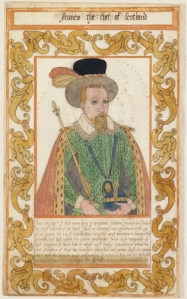“Three crowns in James’s charter”: An Irish poem for the new king
This Sunday is March 24, the date in 1603 when Queen Elizabeth I died, and James VI of Scotland became king of England. When James succeeded Elizabeth to the English monarchy, he also inherited the crown of Ireland.
Although a high king of Ireland was both a legal and historical reality, the concept of an Irish crown was innovative in this period. The bardic poet Fearghal Óg Mac an Bhaird may be the first to have articulated the notion of ‘the crown of Ireland’ as part of a triple monarchy, which he did in his famous poem “Tri coróna i gcairt Shéamais” (Three crowns in James’s charter), an inaugural poem celebrating James’s accession to the triple monarchy of England, Scotland, and Ireland.
The current Folger exhibition, Nobility and Newcomers in Renaissance Ireland, which I curated with Thomas Herron, Associate Professor of English at East Carolina University, includes a facsimile manuscript of Mac an Bhaird’s poem, in the original Irish language. The poem is one of several Irish-language works on display. A fundamental, and immensely interesting, part of the exhibition, these works have been a way for us to show how the Irish language itself was a powerful cultural and social force in the world of Renaissance Ireland. You can hear a spoken passage from the poem, in Irish, in this online audio stop from our exhibition audio tour (the passage from the poem begins after my spoken introduction) and see an image of the poem here as well.
The poem’s fame derives in part from its seeming curiosity: why would a Gaelic Irishman welcome a “British” king? One answer is that Gaelic intellectuals were not absolutely averse to political connection to the monarchy in London, and currying favor with the new king was simply good politics.
On a more basic level, the bardic class hoped to enjoy greater protection and rights under a Scottish king than they had under an English queen: Elizabeth may have had an interest in the Irish language, but she did next to nothing to arrest the destruction of Gaelic culture. James, by contrast, had successfully ruled Scotland for decades and had managed his Gaelic and Catholic subjects with relative tolerance. Many Irish—bards, lords, and even churchmen—held out hope that his reign would usher in better days.
Mac an Bhaird’s poem details the grounds of James’s claim for all three kingdoms. In the case of Ireland, legitimacy derived from blood (Scottish kings having been descended of Irish Gaels) rather than conquest. In traditional motif, then, Ireland was portrayed in the poem as the feminized ‘spouse’ of the rightful king, a union that would bring peace and plenty to the land.
Great hopes, however, were quickly dashed. A mere six years later, in 1609, James’s government would commence the largest and most ambitious of English/British colonial schemes in Ireland, the Plantation of Ulster, and thus the repeopling of Ireland’s northern province with English and Scottish settlers.
Brendan Kane is Associate Professor of History at the University of Connecticut, Associate Director of the University of Connecticut Humanities Institute, and the curator, with Thomas Herron, of the Folger exhibition Nobility and Newcomers in Renaissance Ireland, January 19 to May 19, 2013.
This entry was posted on March 22, 2013 by manifoldgreatness. It was filed under The KJB in History and was tagged with bard, East Carolina University, Elizabeth I, England, exhibition, Fearghal Óg Mac an Bhaird, Folger Shakespeare Library, Ireland, Irish language, James VI and I, poetry, Renaissance Ireland, Scotland, University of Connecticut.







Leave a comment